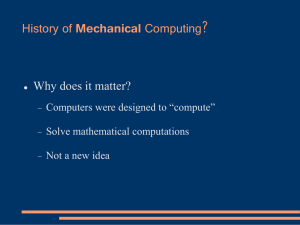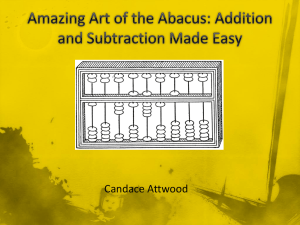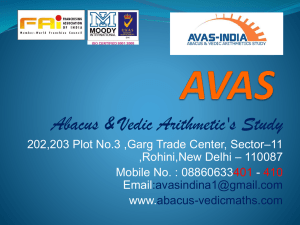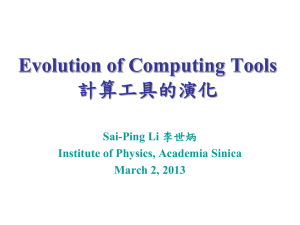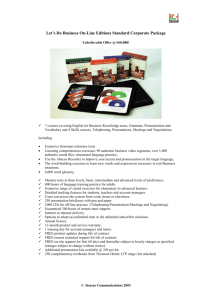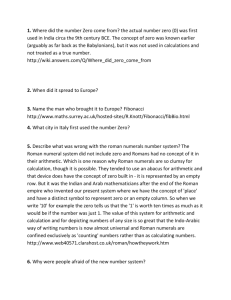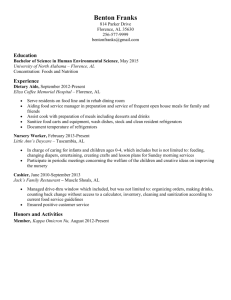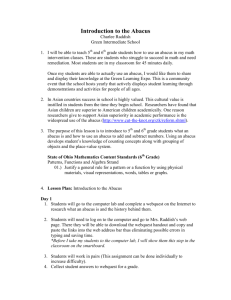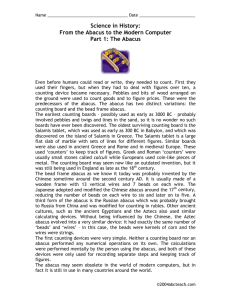PDF Presentation for "History of Optimization"
advertisement
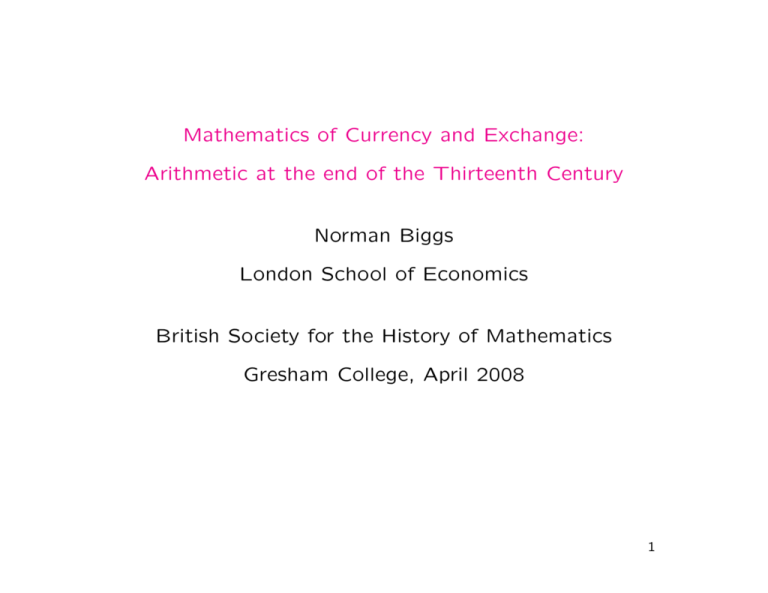
Mathematics of Currency and Exchange: Arithmetic at the end of the Thirteenth Century Norman Biggs London School of Economics British Society for the History of Mathematics Gresham College, April 2008 1 1. Money and trade Part of the Cuerdale Hoard, early tenth century 2 Money can take many forms. Jevons (1872) distinguished between • a medium of exchange (that is money-objects, such as coins, hacksilver, gold dust, cowrie shells); and • a measure of value (that is accounting units, such as pounds, shillings and pence). Jevons argued that money was needed because barter was inconvenient. 3 From an eleventh century ms, published by Salzman English Trade in the Middle Ages (1931) with the title A SIMPLE BARGAIN 4 Coins, like most other money-objects in medieval times, were valued by the amount of precious metal that they contained. Two measurements were needed: the mass, which could be found by weighing; the fineness which could be found by assaying, or by reference to an authority. 5 Weighing was normal in trade. A twelfth century Islamic story [Bib. Nat., Paris] 6 By 1300 there were many gold coins circulating in Europe, all with different mass and fineness. 1: Dinar from Alexandria (1196-1218). 2: Morabetino of Alfonso of Castile (1158-1214), imitating a dinar. 3: Augustale of Frederick II as King of Sicily (1197-1250) 4: Florin, minted in Florence (1252 onwards). 7 A Florentine banker, Pegolotti made a list giving the fineness. His notebook was compiled c1300, and printed in 1936 as La Pratica della Mercatura. 8 Even when the mass and fineness of the coins were known, that did not solve the practical problems of international trade. Sending coins on a long journey was a risky business, so the mechanism known as the bill of exchange was developed in the thirteenth century. Suppose a a shipload of wool is being exported from London to Florence. The following diagrams are based on the definitive account given by Peter Spufford, Handbook of the Medieval Exchange (1986). 9 10 11 12 13 14 15 16 2. The tools of arithmetic It is a truism that the Roman numerals, I, V, X, C, and so on, are not useful for calculations. The Romans used them only to record numbers. For calculations they used calculi, small stones that were placed on a grid known as an abacus. Not much evidence of the abacus survives from the early medieval period, but there is some evidence of other aids to arithmetic. 17 From a tenth century copy of Bede, De Tempore Ratione [BL ms Royal BA XI fo.33v] 18 Around the turn of the millenium, things began to improve. ‘Gerbert’s abacus’, as described by Yeldham (1926) From Ramsey Abbey, c1110, [St John’s Oxford, ms 17] 19 A similar account was given by Turchill (c1130), a clerk in the royal household (Poole 1912). Gerbert’s abacus had two distinctive features. The grid was arranged in columns. The counters were labelled with Hindu-Arabic numerals. 20 It seems likely that during the 12th century Gerbert’s abacus was used in government and by the some of monastic orders that owned large estates. Simpler versions of the abacus, with plain counters, were used by merchants and others. We know that this continued until the 17th century, if not later. But Gerbert’s abacus evolved into a system where the numerals themselves were ‘moved’, rather than the counters. We shall refer to this as pen-reckoning. The methods used for Gerbert’s abacus and for pen-reckoning were very similar. 21 Calculations were normally ephemeral (e.g. done on slates) but some survive. Pen-reckoning c.1320 [Bodleian, ms Ashmole 1522 fo. 18r] 22 There is much confusion about how arithmetic was done at this time. For example, many books refer to the fact that the Florentine bankers guild ‘banned’ the Hindu-Arabic numerals in 1299. In fact, the ban applied only to the use of the numerals in published records, not to the means of calculation, where they had already been in use for many years. By 1345 Giovanni Villani reported that over a thousand children were learning learning abaco and algorismo in Florence. Recommended: Alexander Murray, Reason and Society in the Middle Ages (1978). 23 Another source of confusion! Reisch, Margarita Philosophica (1503) 24 3. Arithmetic of foreign exchange Around 1300, in a typical place X trade would be carried on with a money-object MX and accounts would be kept in X-units. The value of MX was declared to be vX X-units. Specifically: In London (L), accounts were kept in sterling pence (L-units). ML was an amount of silver, known as a mark, worth vL = 160 pence. In Florence (F), accounts were kept in denari piccoli (F -units). MF was a gold florin worth vF = 348 denari. 25 Trade between London and Florence was conducted in terms of an exchange rate: e = eLF = the number of florins that equate to one mark. Note that the corresponding quantity eF L = 1/e. The exchange rate varied because it was dependent on economic factors. 26 Pegolotti gave a table for the exchange between London and Florence: Each line of the table is a statement of the form: α L-units equates to MF =⇒ ML equates to β F -units. 27 Note that: β is expressed in multiples (` s d) of the accounting unit (denaro = d) – this is simply a matter of convenience; two types of money occur, because money-objects were used for payments and the books were kept in accounting units – this requires some explanation. 28 If α sterling pence make a florin, then α/vL marks make a florin. Hence α/vL = 1/e. Similarly β = evF , and so v v β = L F. α Pegolotti gave a table of values of β as a function of α. 29 A typical user of the table would have been a clerk in Florence, who needed to account for goods worth m marks, given that the ‘exchange on London’ was α. He would look up the corresponding β and multiply to get the answer, mβ. But the compiler of the table had to divide vLvF by α in order to get β. This implies two different levels of expertise: the first using a simple abacus, the second using Gerbert’s abacus or pen-reckoning. 30 4. Conclusions and Implications • There were different levels of expertise in the practice of arithmetic. The higher levels are often obscured from the modern historian, partly by the imbalance of evidence, and partly by intentional secrecy. • Numerate thinking was driven by commercial considerations as well as scientific ones. But progress in conceptual terms was slow – for example in framing the idea of number as a continuum. (Decimal notation does not appear until the sixteenth century.) 31
